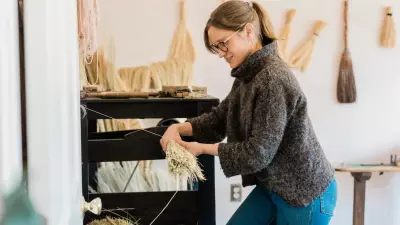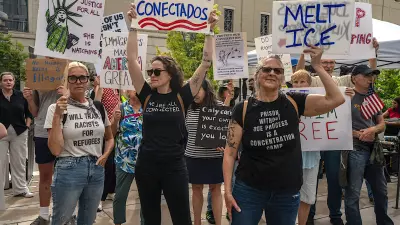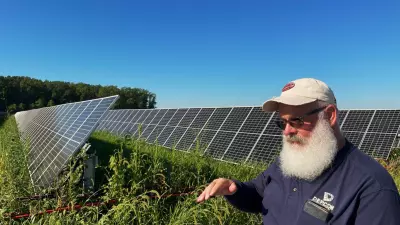Rural arts programs helped Eastern Kentucky maker Cynthia Main develop Sunhouse Craft, a sustainable business with an Appalachian sense of place.

Main’s origin story parallels that of many small-town makers. She was scrappy, sleeping in a hammock and working hard to make a living. But now Sunhouse Craft is on a growth trajectory to reach a seven-figure revenue in the next several years.
Main’s livelihood has always been at the intersection of the land and handmade craft. She began as a woodworker, teaching the craft to formerly incarcerated people. But it didn’t scratch her itch for a truly sustainable business. In 2012, she took a deep dive into traditional crafts, seeking a career that she could dedicate her life to.
“I found there was a real hole in the market when it came to handmade brooms,” Main said in an interview with the Daily Yonder. “Manufactured elements had seeped into the craft and it had lost its natural roots. People at craft markets found my work really surprising.”
Arts Development in Rural Appalachia
Good timing has been an element of the business’s success. Its emergence coincided with a booming interest in handcrafts, Main said. But strategy has played a big role as well. Her first growth period happened when she discovered an arts accelerator program in Berea, Kentucky, that helped her develop the skills for online marketing. The Sunhouse Craft website went live in 2018. After that, business soared.
But revenues eventually plateaued, and Main sought to expand. She wasn’t seeking growth for its own sake, however. Main is driven by sustainability and community. With larger revenues, she can pay her small staff a living wage and offer her restored historic storefront as a community gathering space, while moving closer to her goal of developing a 100% local supply chain.
“I want to offer abundance to my community instead of being extractive,” Main said. “Just yesterday, I interacted with six local people who feel the ripple effect of my business. That’s exciting.”
As the Sunhouse Craft website states, “sustainability is another name for love.”
Sunhouse Craft already uses locally grown and milled wood for the broom handles and natural dyes from a local producer. But Main wants to take things a step further. Her most ambitious effort to date is resurrecting a disappearing crop: organic broomcorn, a variety of grain traditionally used to make brooms.

For the past four years, Main has been working with Bryce Baumann of Lazy Eight Stock Farm to rediscover how to grow, harvest, thresh, and store this heritage crop. Baumann has a six-acre patch of broomcorn; Main believes they are currently the largest-scale organic broomcorn growers in the United States. She is on target to reach her goal of using this material in all of the brooms Sunhouse produces by 2027.
Main is increasing sales without licensing or mechanizing the work. Sunhouse makers continue to craft every broom they sell by hand, using human-powered antique equipment.
As Main was developing this infrastructure for a regional supply chain, she also found herself asking questions that no one in her small Appalachian town could answer. Namely, why were there hardly any mid-sized craft businesses, and how could Sunhouse become one? Even in her entrepreneurial imagination, she couldn’t envision a business that brought in more than $250,000.
“There are a lot of great resources locally for starting a business but not for growing it,” she said. “There aren’t really any good models, either.”
International Nonprofit Helps Makers Create Sustainable Arts Economies
In 2023, Main discovered Nest, an international nonprofit organization aimed at helping makers and artists develop economic opportunities. Nest has a program in Appalachia to specifically help local artists with their business development. Several of its participants have included rural members, like the Gees Bend Quiltmakers in Boykin, Alabama, and a national Indigenous artisan program – but Appalachia was the most ambitious rural project to date.
Nest offers its trademark assistance in three main pillars: financing, learning & mentorship, and market access. The organization’s first step in serving a new city or cohort is mapping what supports already exist and identifying unique assets and challenges.
Eastern Kentucky is marked by a deep sense of place and a strong tradition of heritage crafts, but the area also suffers from persistent economic challenges.
A 2024 research report from Nest revealed that a significant issue in rural Appalachia was access to markets. To work towards financial sustainability, Nest works with makers in the region to build out multi-tiered distribution strategies, like craft fairs, online sales, wholesaling, and teaching classes and workshops. Another concern was uniquely rural: a need for a closer-connected community of peers.
Nest’s usual model of convenings hasn’t proven tenable because of how dispersed artisans are in the region. Nest staff have adapted to rural Appalachia’s geography by focusing on one-on-one mentorships with members of the cohort. Main was able to focus her support on scaling production while maintaining the handmade quality of her brooms.
The game changer for Main was being selected for Nest’s Makers Future Fund, a coaching and capital access program for makers wanting to grow their businesses. As a part of the grant cohort, Main found a world-wide community of craft entrepreneurs who were also in the process of scaling their businesses. A personal adviser helped her define what a growing, healthy business would look like and helped her construct a strategy to get there. The third benefit of the program was a $5,000 stipend for the makers.
“Nest is trying to straddle systemic change coupled with making a real impact for individual makers,” said Nest Founder and Executive Director Rebecca Van Bergen in an interview with the Daily Yonder. “We want to change the narrative of craft – it can be a main driver of employment and is an investable, smart sector.”

Main and her coach refined her business by tweaking pricing product lines and listing information. While Sunhouse Craft already had a substantial wholesale business, Main knew this was an avenue she wanted to grow. She used the stipend to attend her first wholesale show, Shoppe Object in New York City. It turned out to be a transformative investment in her business.
“I literally cried at the reception I received,” Main said. “It was shocking, just phenomenal.”
Main doubled her business revenue during her time in the Makers Future Fund and anticipates it will triple in the next year. Now, 70% of Sunhouse Craft revenues come from wholesale business and 30% come from direct online sales.
Main also got an answer to that persistent question about business sizing: Once creative entrepreneurs jump the initial hurdles to design for scale, they have the processes in place to achieve significant growth.
A Handmade Future
The day I visited the Sunhouse Craft shop, Main and another broom maker, Bethany Marker, were in the sunny front room experimenting with new styles. Marker was winding rope around a wooden handle and an alternative broom fiber, using a machine with a foot pedal similar to a spinning wheel. Main was weaving string around wooden dowels on an elaborate version of a loop potholder loom. Even in the midst of growth, she is committed to spending more time each week making brooms.
Though Main has reached a measure of success, she explained that these “teenage” years, marked by movement and change, aren’t easy. Boxes in the entryway are Sunhouse’s first-ever shipment to Europe. Next month, Sunhouse staff will move the woodworking portion of the shop offsite to expand the production floor. Main reminds herself to savor the gift of making things by hand.
“I believe in a handmade future, but it is still an open question if it is possible in rural America,” said Main. “We are on a narrow path up a steep mountain, but that makes it more exhilarating.”







